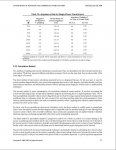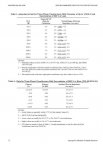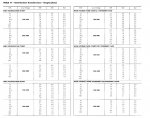You are using an out of date browser. It may not display this or other websites correctly.
You should upgrade or use an alternative browser.
You should upgrade or use an alternative browser.
IEEE reference transfomer impedance data
- Thread starter anbm
- Start date
- Status
- Not open for further replies.
JDBrown
Senior Member
- Location
- California
- Occupation
- Electrical Engineer
Is this what you're looking for?
View attachment 9761
Sorry about the poor quality of the scan. At least it's legible, though.
This works, thanks a lot!
Is this what you're looking for?
View attachment 9761
Sorry about the poor quality of the scan. At least it's legible, though.
By the way, do you have similar information for single phase xfmr?
Julius Right
Senior Member
- Location
- Israel
- Occupation
- Electrical Engineer Power Station Physical Design Retired
JDBrown
Senior Member
- Location
- California
- Occupation
- Electrical Engineer
This is the only single-phase information I found in that IEEE book. In case you can't read the fine print below the table, it says, "*National standards do not specify %Z for single-phase transformers. Consult manufacturer for values to use in calculation." So I'm not sure how useful this will be to you, but here it is anyway.


Julius Right
Senior Member
- Location
- Israel
- Occupation
- Electrical Engineer Power Station Physical Design Retired
It is very interesting in the new edition of IEEE 242 from 2001 it is no indication of transformer impedances.
I think these data was copied from ANSI/IEEE C 37.010 from 1979 and now are obsoleted [on 1999 Edition].:ashamed:
I think these data was copied from ANSI/IEEE C 37.010 from 1979 and now are obsoleted [on 1999 Edition].:ashamed:
JDBrown
Senior Member
- Location
- California
- Occupation
- Electrical Engineer
That's very possible. The only edition of IEEE 242 I have access to is the old 1986 one, and I know transformer design hasn't remained stagnant these past 28 years.It is very interesting in the new edition of IEEE 242 from 2001 it is no indication of transformer impedances.
I think these data was copied from ANSI/IEEE C 37.010 from 1979 and now are obsoleted [on 1999 Edition].:ashamed:
I got a nice spreadsheet of transformer R/X/Z values from my local Eaton rep about 5 years ago, and that's what I tend to use for my short circuit calcs. There are different values for standard, K-4 and K-13 rated; copper and aluminum windings; and 150, 115 and 80 degree temperature rise -- giving me a better chance of having my calcs match up with reality.
mivey
Senior Member
They have become more efficient, thus generally lower impedance.That's very possible. The only edition of IEEE 242 I have access to is the old 1986 one, and I know transformer design hasn't remained stagnant these past 28 years.
That would be useful information to share with the class.I got a nice spreadsheet of transformer R/X/Z values from my local Eaton rep about 5 years ago, and that's what I tend to use for my short circuit calcs. There are different values for standard, K-4 and K-13 rated; copper and aluminum windings; and 150, 115 and 80 degree temperature rise -- giving me a better chance of having my calcs match up with reality.
JDBrown
Senior Member
- Location
- California
- Occupation
- Electrical Engineer
Ask, and ye shall receive...They have become more efficient, thus generally lower impedance.
That would be useful information to share with the class.
Apparently, you can't upload Excel files, so I had to tack a ".doc" extension onto it. Just delete that part from the file name, and you should be able to open it.
I don't know if it was a work in progress when I got it, or what, but there seems to be some information missing. It's still a useful tool, though.
Attachments
mivey
Senior Member
Thanks.:thumbsup:Ask, and ye shall receive...
- Status
- Not open for further replies.


